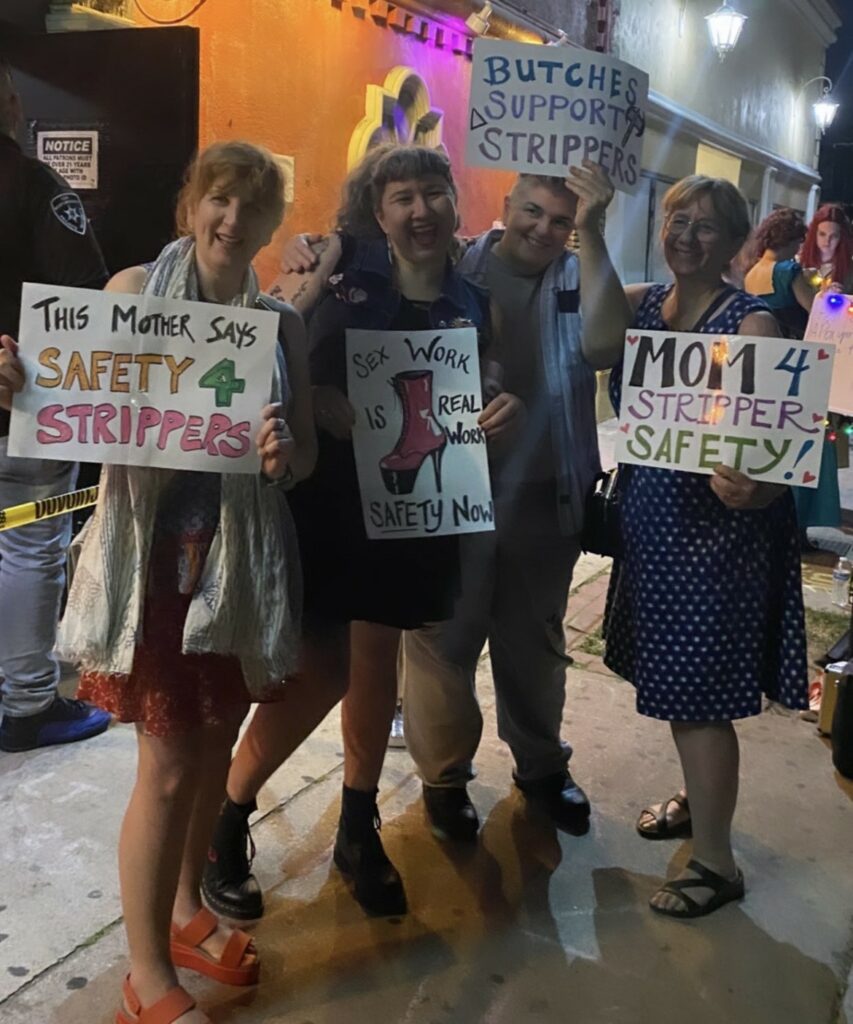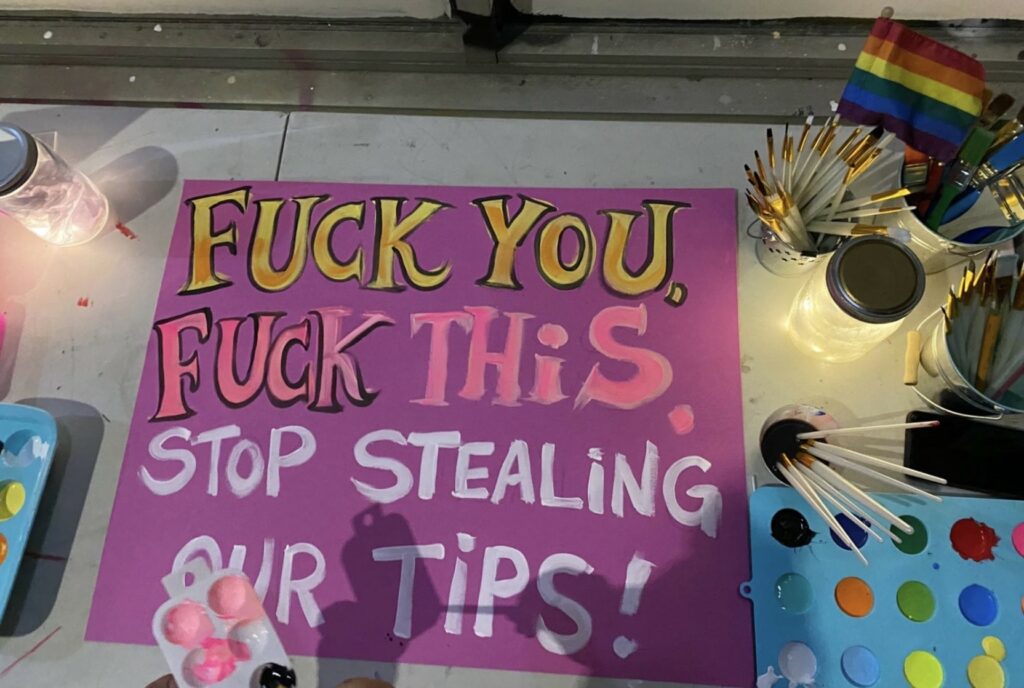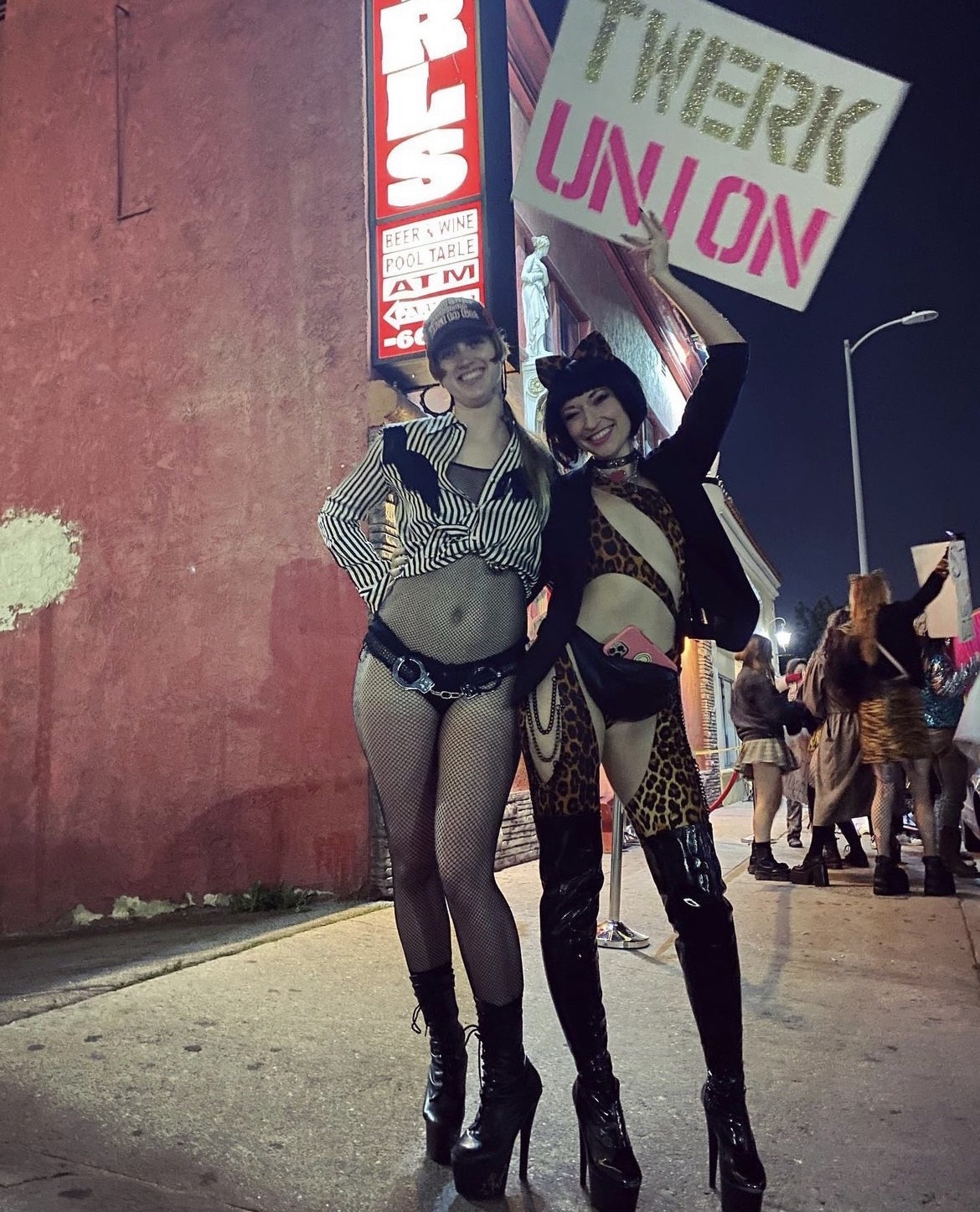In March 2022, 18 strippers working at the Star Garden Topless Bar in Los Angeles went on strike after two of their co-workers were allegedly fired for speaking out about safety concerns in the establishment. Just over a year later, they became the only unionized strip club in the county — until this September when they were joined by the Magic Tavern Dancers of Portland, Oregon.
The successful formation of a union in an industry like stripping — defined by high turnover, irregular pay scales, a culture of competition fostered by employers and stigmatized labor – is incredibly rare. Before Star Garden and Magic Tavern, the feat had only been achieved once before, at the Lusty Lady Theatre in San Francisco in 1996, which has since closed its doors.
The journey to unionization was not an easy one. Facing every union-busting tactic in the book, Equity Strippers Noho, formerly known as the North Hollywood Stripper Strike, was actively picketing outside of Star Garden for a whopping eight months before they officially read the results of their union election: a unanimous “yes.” In another attempt to quell worker organization, management challenged the results of the election in court. Despite these efforts the votes were confirmed, and the union was formally recognized in May 2023.
While the sheer determination and grit of the organizers is evident, it was the uniqueness of their protest style that set the North Hollywood Stripper Strike apart. Five components of the strike stick out as both exceptional and potentially applicable to other working-class battles: harnessing the unique skills of the organizers themselves, engagement of the location’s customer base, creating a spectacle, making creative use of social media, and the establishment of a digital worker cooperative.
All of these techniques might not work across every industry and workplace, but they provide a jumping off point to think creatively about how organized labor and working-class actions can (and must) adjust to the changing conditions of the digital age. At a time when strikes and other forms of labor action are escalating across a wide variety of industries like auto-work, acting, writing, and more, these techniques could prove fruitful to new organizing efforts.
Know your strengths

A good stripper, more often than not, is a confident, clever, and creative business person who knows how to smile and work a client for cash, even when they are mentally and physically exhausted. In the case of the North Hollywood Stripper Strike, these same traits made for an excellent organizing team.
Jordan Palmer, legal council for the Stripper Strike and team member for the organization Strippers United, explained to me just how critical the workers were to a successful picket:
I would say strippers are great organizers… There are certain jobs that require certain skills or where you build certain skills. All night long, strippers are organizing people out of their wallets. They know what they’re doing, they’re talking to people, they are communicating all night long with customers in the club. They are good organizers. They were great at organizing customers on the picket line, convincing them not to go into the club. They were Olympic-level organizers in so many different ways. And so I think that is a natural skill that a lot of strippers have.
Maintaining morale, creativity, connection and heart for a protracted picket takes exceptional levels of ingenuity, grit and guts. The strippers of Star Garden who cleaned up at the club with artistry and grace every night were prepared and well-suited to the challenge.
While workers in every profession might not share the same skill set as strippers, it is important to evaluate what skills that members of your organization can bring to the table. Nurses tend to be kind, matter-of-fact and tough as nails. Teachers are often patient, clever and full of mettle. Food service employees have killer emotional intelligence and are quick on their feet. The lesson is not to replicate the skills of the Star Garden dancers, but to understand the value and talents that each member of an organizing team can contribute to the cause. Often in labor organizing, certain jobs require specialized skills and qualities. In an organizing setting, leveraging those can be the difference between victory and defeat.

Engage your customer base
In addition embracing the skill set that makes for a successful stripper, the strike pulled another key component out of the club and onto the picket line: their customers. Palmer explains that regular customers with whom the performers had a positive relationship “showed up for the dancers in more ways than just contributing to the strike fund… They were the people who were showing up before the general public was interested, before the media was there, before other unions knew about it or were showing up.”
In her experience as a labor lawyer, Palmer further explained that she hasn’t seen many other unions or organizing efforts “really leverage workers’ relationships with their customers for the sake of the campaign and bring the customers into the campaign,” and recommends this course of action.
Within stripping, relationships with regulars tend to be some of the most lucrative aspects of the job. For service-based industries, as in the case of stripping, forming connections between worker and consumer can be an avenue for establishing truly positive bonds of camaraderie–and significant strategic leverage. During periods of labor dispute, organizers can tap into these relationships to ally against management for the sake of worker wellbeing. This tactic of engaging your customer base likely would be very successful in vast service industries like healthcare and education.
Create a spectacle

Even with a great team, picketing for extended periods can be exhausting and demoralizing. For the members of the Stripper Strike, an infusion of creativity, passion and fun helped to prevent burnout. In our interview, Palmer referenced a news report in which one reporter referred to the Stripper Strike as “the most fun picket line of all time.” On the club’s busiest nights, members of the strike could be found out on the sidewalk putting on their own shows that put the scab performances happening within its doors to shame.
These picket parties, in conjunction with the social media savvy of the organizers, garnered attention for the strike across both social and news media. These parties included a series of theme nights that were announced in advance by the Stripper Strike’s social media accounts, and the performers would do what they do best: wow a crowd. Some of the workers’ favorite theme nights included one in which dancers dressed up as OSHA violations committed by Star Garden, such as “broken glass” and “hole in the stage.” Other theme nights included “Hot Labor Summer” day featuring Amazon Labor Union’s Chris Smalls and a sidewalk slip-n-slide, and a “Braveheart” theme where the performers reenacted scenes from the movie and charged the club. It was the creativity of their picket lines that thrust the Stripper Strike into the public eye and made their workplace protests a bonafide event.
According to Selena, one of the dancers whose firing initiated the protest, the picket parties were initially conceptualized to bring the show outside and keep customers from going into the establishment. However, as these events grew in attendance and complexity, they became much more than a way to hurt Star Garden’s business. One of the stripper-organizers, Velveeta, explained:
[The picket line] was an essential part of our success because for one, it gave the media a touchstone and we were able to generate a lot of great content for social media to keep people engaged. It became a community space where we could connect with allied orgs and just general allyship. So that was a big part of it. The picket line really served a purpose well beyond the explicit purpose of hurting their business and turning people away.
At these themed picket events, the stripper-organizers were able to tap into creativity, fun, and community in a way that was not always accepted within the doors of a formal club, and the community responded.
At these sensational events, spectacle was key. Folks from all over — customers, social media followers, fellow labor organizers and more — would come to these lines for the party and stay for the solidarity. While other organizers may not be able to capture the same level of theatricality that the Stripper Strike achieved, making a sometimes-onerous activity like picketing something that invigorates participants can both draw in supporters and motivate organizers to continue the good fight.
Harness the power of social media
The picket parties of the Stripper Strike would not have garnered the level of attention that they did without the clever use of social media. Many performers in the sex work industry rely on social media to carry out individual marketing, and those skills seamlessly carried over into digital organizing for the Star Garden dancers.
Using elements of graphic design, humor, education and more, @equitystrippersnoho was able to gain over 16,000 followers on their Instagram and Twitter pages combined. Social media helped to get people interested in their fight, allowed for inter- and intra-industry solidarity, and inspired community members to join them on the line at their famous picket parties.
Using their existing social media expertise, the organizers of the Stripper Strike were able to not only recruit supporters to their picket line events, but also to tell their own story without having to rely on news media. Stripper-organizer Reagan expressed that she: “…definitely feel[s] that social media has been one of our greatest tools as far as representing ourselves and our movement and speaking on behalf of ourselves as strippers, as well as crafting the image of our movement to look super fun and like something that you want to follow and to be a part of.”
Unlike their foremothers at the Lusty Lady whose success in unionizing was largely contingent upon positive media coverage, the members of Equity Strippers NoHo were able to represent their own ideas, experiences and personalities through social media.
In the digital climate of the 2020s, social media is a major force in turning the tide of public opinion. It can be used to connect people across the world and form lines of communication, solidarity and friendship. For labor organizers, social media is a key element to being able to tell your stories without having to rely on tenuous connections within the news media industry. Organizers can be inspired by the success of Equity Strippers NoHo, who leveraged their social media literacy to spread the word about their cause and their pickets while maintaining a firm grasp on their own image.
Seizing the means of seduction

One of the most unique aspects of the North Hollywood Stripper Strike represented both the means and the goal of the months-long strike: The Stripper Co-Op. What began as a way for performers to work while clubs were shut down during the pandemic, the idea of a digital worker cooperative of performers became a way for strippers to take control of the casting, creative direction, and finances for their performances. The level of freedom that came to dancers when they were no longer shackled by the arbitrary rules and limitations of management changed the way that many of the Stripper Strike organizers viewed themselves and their work. Charm explained that:
…it was this totally different kind of avenue I hadn’t taken before in terms of online work. And then beyond that, just the freedom that we had with literally no management and realizing like, ‘Oh, we don’t need a DJ. We don’t need a bouncer. We don’t need a manager. We don’t even need a venue. We can do this all remotely and still gather people.’ So that was an amazing experience for me because I think that really taught me about the capabilities I had. I knew I was capable as a performer, but also as an organizer and a producer, and also just making community with my other strippers.
The Stripper Co-Op formed from a couple of different virtual shows that arose during the pandemic, and came to encompass many of the Star Garden performers as well as numerous other talented performers within the industry.
Velveeta explained that as the strike progressed, the organizers were hosting hybrid shows through the Stripper Co-Op that acted as fundraisers for the strike. The Co-Op shows were used, in part, as a way to bolster their strike fund and keep the performers afloat while they remained locked out of Star Garden.
Palmer explicitly recommends this practice to other strippers interested in organizing.
I would say a great way for them to fundraise and make money could be to do what the Star Garden dancers have done with their co-op shows. And I think one thing that’s so clever about that is that it’s a chance for them to be together and create their own strip club and create their own work environment and show each other what it could be if they win, what the strip club could be like to compare and contrast that with what it’s like now for them…I think it’s like, it’s good to visualize that and it’s also a good bonding exercise and it is literally just a good way to make money.
In one, now-retired, fundraising effort to support the workers’ attempt to buy out Star Garden as a brick and mortar home for the Stripper Co-op, the workers called for supporters to help “seize the means of seduction!” While the strippers were unable to buy out the physical space, their use of the co-op still helped the dancers to realize the potential of a worker-run organization.
Now, over a year after the strike began, the unionized strippers of Star Garden are back in North Hollywood. The club’s doors have officially reopened and the fired performers have been reinstated.